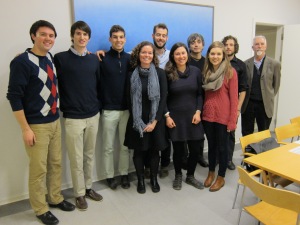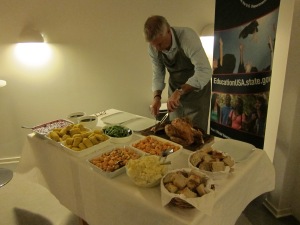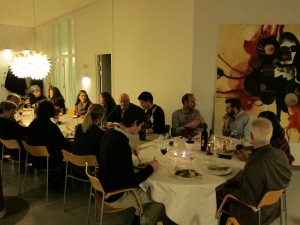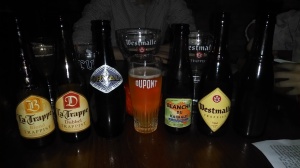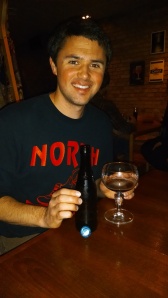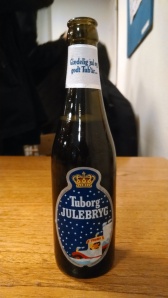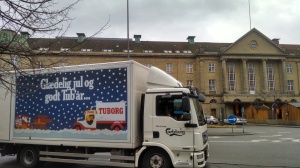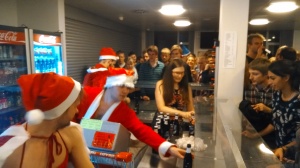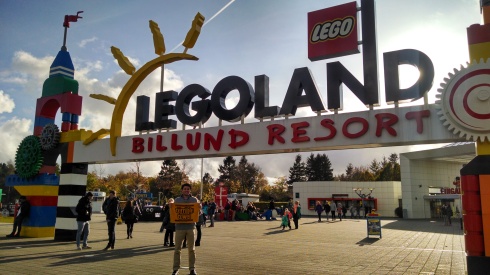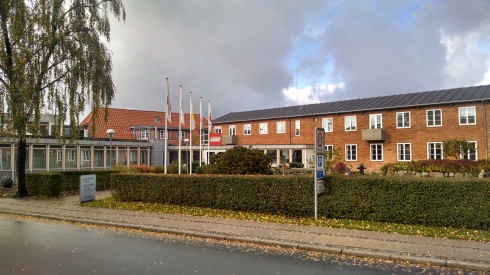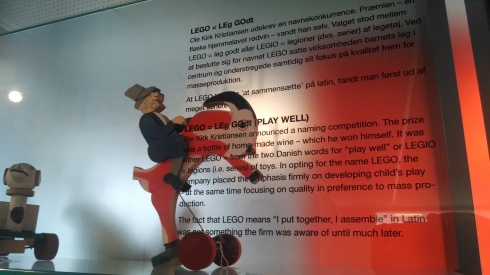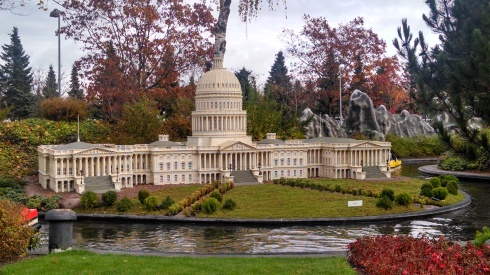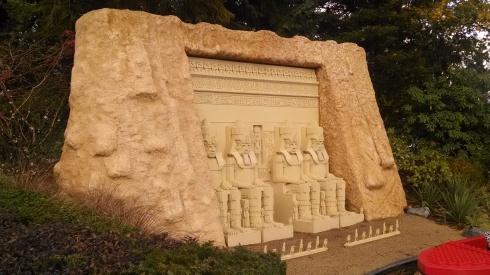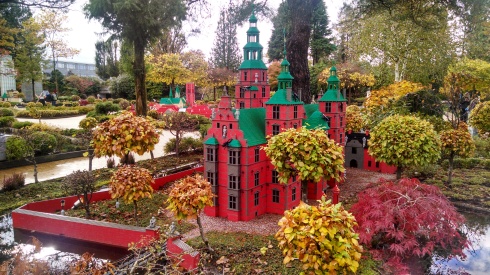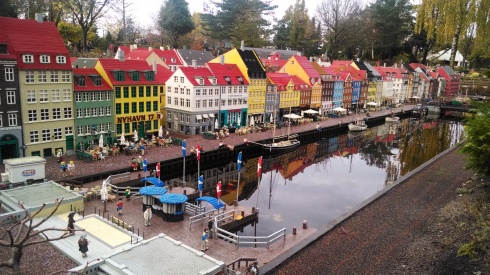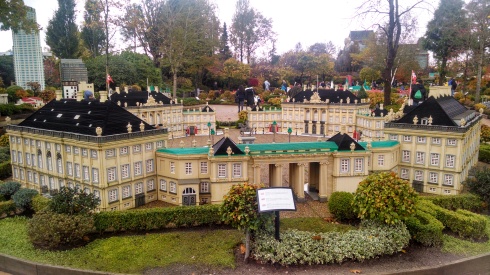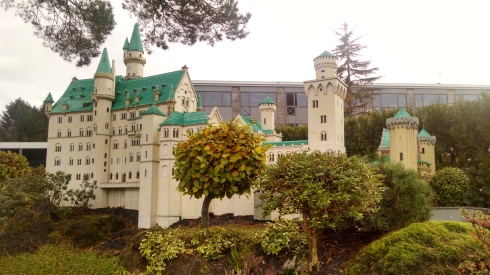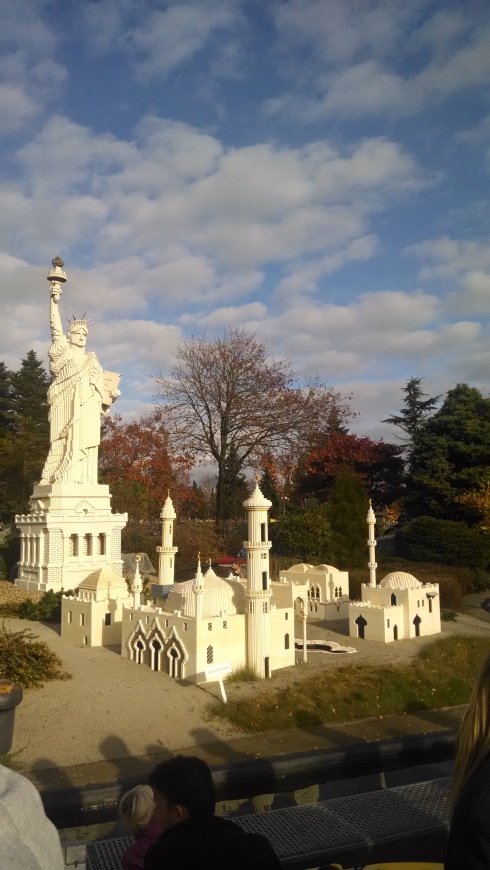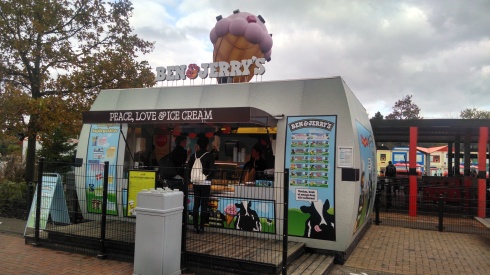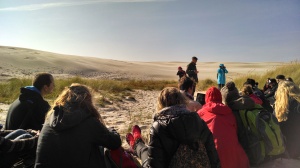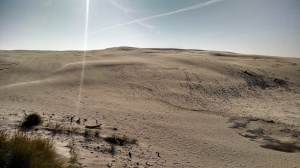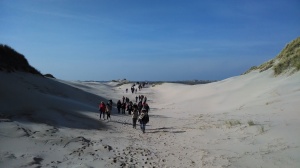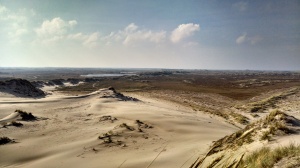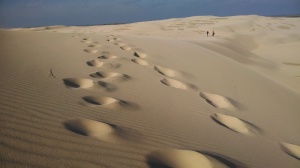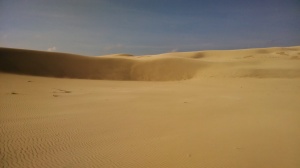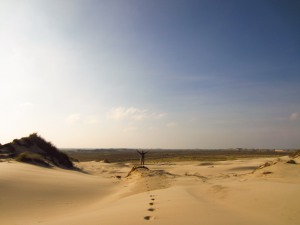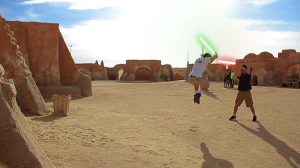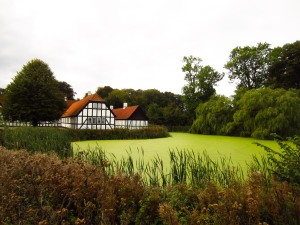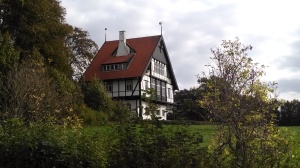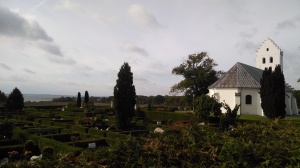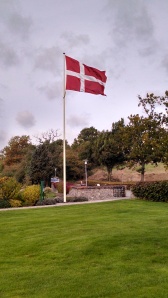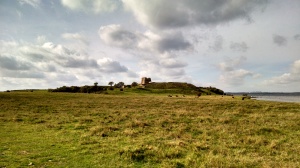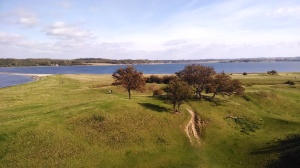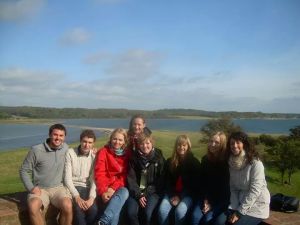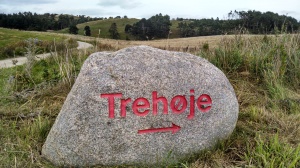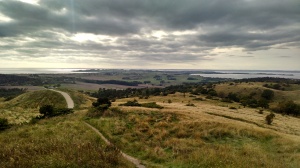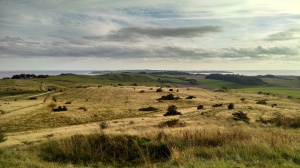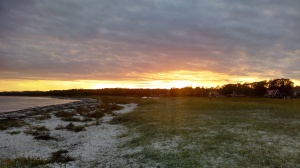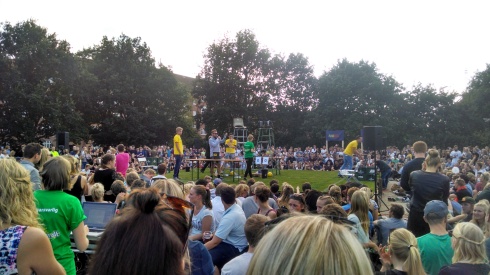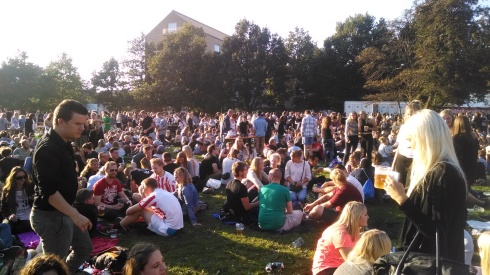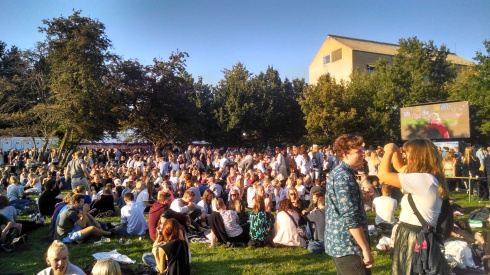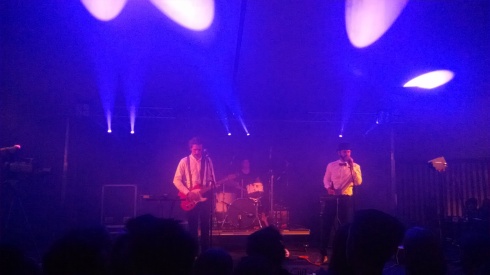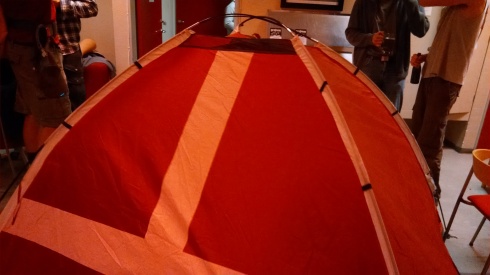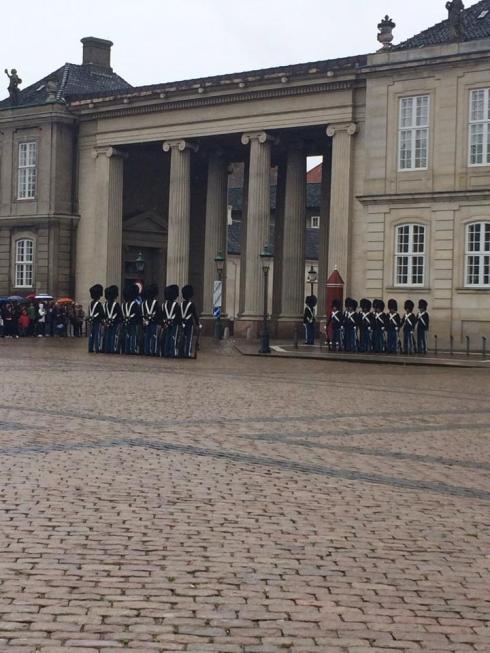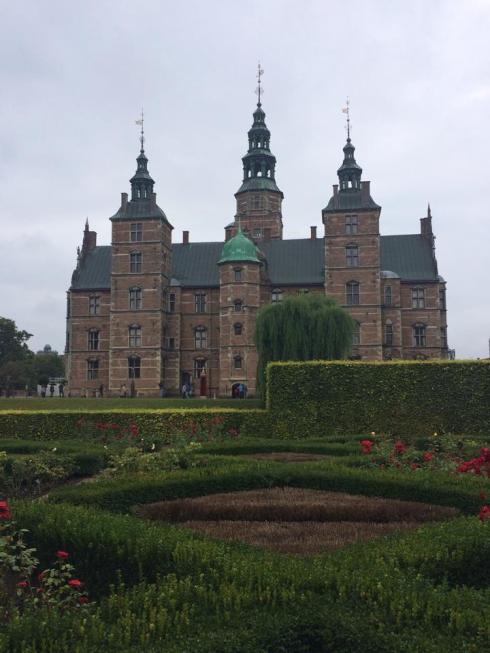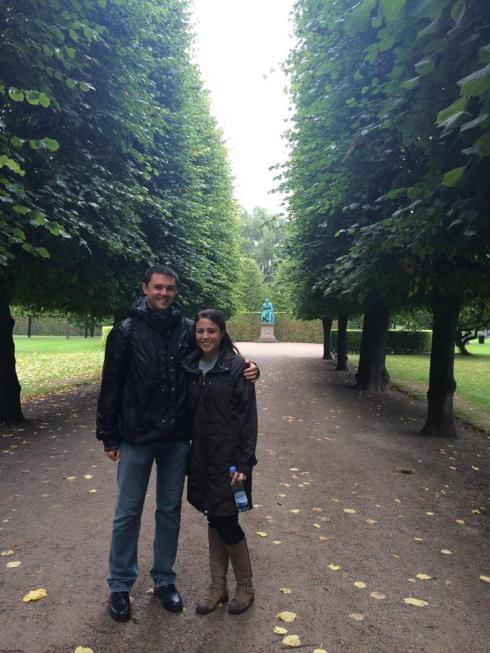No Thanksgiving in Denmark – no problem! The Danish-American Fulbright Commission had us covered. On Thursday, November 20th (a week before the real Turkey Day) the Commission hosted a Thanksgiving dinner with all the trimmings for the American Fulbright grantees in Denmark (and Greenland) this year. It was a chance for all of us grantees to update one another on our research and experiences thus far, and to enjoy a home-cooked meal that could have rivaled an American Thanksgiving dinner. A special thanks to everyone at the Commission for organizing such an enjoyable event for us grantees! Here are some photos – courtesy of Anne at the Commission:
A Little Taste of Belgium (in Denmark)
27 Nov*This blog post is dedicated to my Uncle Brad, Michelle, and Dr. Tony Godzieba, all three of whom I am forever indebted to for introducing me to the sweet nectar of the gods that is Belgian beer.
Århus University has a student bar on campus called the Studenterhus. It is well-stocked with an impressive collection of Danish, German, and most notably, Belgian beers. This enticed a few friends and I to spend an evening trying their best Belgian brews – and we were not disappointed. Their massive menu featured such standouts as Chimay, La Trappe, Rochefort, Orval, Tripel Karmeliet, and Westmalle (both their Dubbel and Tripel, in case you were wondering). But the crème de la crème was none other than Westvleteren (yep, you read that right):
Commonly considered the best beer in the world (if you don’t believe me, see also here and here), Westvleteren is brewed by a group of Flemish monks in the Trappist Abbey of Saint Sixtus of Westvleteren in western Belgium, close to the French border. The monks live a solitary life of prayer and make their world-famous beer only to finance their monastery, and as a result produce very limited quantities of their prized brew in humble, label-less bottles. This makes the beer almost impossible to find – even in Belgium (one rare exception was when the monks needed money for a new roof, which prompted them to export a batch to the U.S. – more on that here and here). So that’s why we were both shocked and astounded to see a handful of Westvleteren 8s sitting in a locked fridge at the edge of the bar. Despite the steep price (too steep to repeat) we paid up, split a bottle, and drank her down – sip by precious sip. Stupendous. When we asked how in the world they managed to import the best and maybe the rarest beer in the world, all we could get out of the bar tender was “we have a connection.”
Luckily, this was not to be our last night of Belgian beer and debauchery. The very next weekend, Karen, one of my fellow exchange students, who is from Flanders (the Flemish-speaking part of Belgium) was hosting some of her friends from her hometown. When Karen’s friends saw that I had brought a few (very modest) Belgian beers to the party, they were quick to make friends, and before long had introduced me to Rodenbach, a red Flemish sour ale brewed in their hometown of Roeselare in West Flanders which they had brought with them.
By the end of the night, we were all planning a pilgrimage to the Westvleteren Brewery. Until then, I think the Studenterhus has got us covered…
J-Day
25 NovIf you happen to find yourself in Denmark on the first Friday in November, you’re in for a treat. On this magical day every year, the Danes celebrate “Juledag,” or for short (and translated): J-Day.
J-Day marks the momentous release of the Danish beer company Tuborg’s Julebryg, or Christmas beer.
The tradition is not difficult to take part in, since Tuborg trucks drive to 100s of towns throughout the country, stopping often to distribute free Christmas-beer and funny blue hats to pretty much anyone within sight of the truck.
Things are a bit more regulated at the bars, where the taps aren’t allowed to pour the good stuff until 8:59pm exactly. If you start early, you’re likely to be ratted out by one of your customers and will be placed on Tuborg’s “black list” for next year’s J-Day (and you thought finding a lump of coal in your stocking was a tough punishment). National Public Radio has more on J-Day here: http://www.npr.org/blogs/thesalt/2012/11/02/164185006/christmas-comes-early-for-denmarks-beer-drinkers
When J-Day arrived earlier this month, some friends and I were lucky enough to be at an on-campus, student-run Friday Bar which was partaking in the J-Day tradition, so we got to experience the festivities first hand (and not a minute before 8:59pm):
Legoland!
31 OctLast Saturday, I made a long-awaited pilgrimage to the birthplace of Lego – the makers of those most magical plastic toy building bricks which defined my playtime as a child. Lego was started as wooden toy company by a Danish carpenter who was out of work during the Great Depression. The company gradually grew until it had its big breakthrough in the 1960s – a plastic brick which could be locked or attached to other plastic bricks, and the rest is history. Although it recently became the largest toy company in the world, Lego remains family-owned and is still headquartered in its humble, countryside birthplace of Billund, population 6,194. Lego actually comes from the Danish phrase “leg godt” which translates into “play well” (coincidentally, “lego” also means “I put together, I assemble” in Latin, although the founders were not aware of this at the time).
My tour guides for the day were the wonderful and gracious Povl Arne Hoier and Jytte Hoier. Before retiring recently, Poul Arne spent several decades working for Lego’s sales and marketing division. After beginning his career in Billund, Poul Arne’s job took him first to Canada and then to Connecticut – where Lego’s North American headquarters is located. While living in the tiny town of Suffield, the Hoiers befriended my Uncle Greg, Aunt Julie, and cousins Will, Andy and Tim, who were their next-door neighbors. Because of this connection, the Hoiers were nice enough to invite me to join them for an employee-only tour of the original Lego workshop, as well as to participate in a company program which highlighted the new “Lego House” that is being constructed in Billund. Although now retired, the Hoiers still help host these sorts of company events, and although most of the presentations were in Danish, I still learned a lot about the history of the company and I got an exclusive, behind-the-scenes look at Lego (and a free breakfast):
After wrapping up the morning events, Poul Arne and Jytte were nice enough to not only drop me off at the original Legoland park, but also to get me into the park for free! While there are plenty of rides in the park, I spent most of my time admiring the impressive lego creations that populated “Miniland.” Below are some pictures – hopefully they conjure up some pleasant childhood memories for you, just as they did for me:
The Danish Sahara
12 OctA few weekends ago, I journeyed north with a big group of international exchange students on a university-organized trip to Skagen – the northern most point in Denmark. Skagen has long been a hub for shipping and the fishing industry, as well as a home for Danish artists and a popular vacation spot for wealthy Danes. But the draw for us was the chance to stand at the spot, called Grenen, where two major bodies of water – the North Sea and the Kattegut – collide with each other. It really is a neat sight, unlike any I’ve seen:
However, the highlight of the day by far was the Råbjerg Mile, a migrating coastal sand dune. The largest of its kind in Northern Europe, the horseshoe-shaped dune covers roughly half a square mile and reaches heights of 130 feet above sea level. We had a great tour guide who took our large group out to some very neat spots along the dune:
Sifting through sand dunes like these in Denmark of all places was wild and completely unexpected, and took me back to Tunisia and the sand dunes of the Sahara Desert, where my former (and definitely future) travel compadre David Sanchez and I journeyed during our spring break at DIS in 2012. A few months ago, David (who is traveling the world on a Keegan Fellowship – more on that here) used an innocent Facebook comment I made as inspiration to return to Istanbul, which we also explored while studying at DIS. Well David, I may not have returned to Tunisia, but this is about as close as I’ll get to one-uping you while I’m in Denmark:
Till the next camel ride, brother…
Mols Bjerge National Park
11 OctFour Germans, a Frenchie, an Italian, a Belgian (from Flanders, not Wallonia, in case you were wondering), and an American. Is this the start of some sort of internationally-themed bar joke? Nein nein nein nein nein. These were the nationalities represented in our group of friends who visited Mols Bjerge National Park in September!
The park is located on a peninsula across the sea from Århus, about an hour away by bus (or two depending on what part of the park you’re visiting). We began our day-trip at the Kalø Manor, part of an estate formerly owned by a wealthy German. After World War II, the Danish government seized the land as part of war reparations, eventually turning it into the national park it is today:
Here’s the estate’s old hunting lodge:
On our way through the forest, we passed a beautiful Danish church, with its iconic white-washed exterior and a Danish flag proudly flying out front:
Known as Dannebrog, the Danish flag is the oldest continuously-used national flag in the world, dating back to a battle in present-day Estonia in 1219. The Danes were there on a crusade to convert the local heathens to Christianity, and were losing badly, until their beloved Dannebrog fell to ground from heaven. King Valdemar II seized the flag, rallied his forces, and led the Danes to victory. Today, Dannebrog is flown from front-yard flagpoles, store-front flagpoles, mini decorative table-flagpoles, and even from toothpicks! Public holidays, festivals, state visits, birthdays, baptisms, confirmations, weddings, anniversaries, and national football and handball team victories – these are all occasions to hoist the red and white cloth. I should note, however, you need not feel threatened by this quite overt sense of nationalism: tiny Denmark hasn’t been a threat to anyone for hundreds of years 😉
Next was a trek across a narrow strip of land to the ruins of Kalø castle, which dates back to the 1300s. This of course provoked Remi – the group’s lone Frenchie – and myself to make several references to the “French Taunting” scenes in Monty Python and the Holy Grail:
After breaking for lunch, we set out for our lone afternoon destination: Trehøje – or Three Hills – which are actually ancient Bronze Age burial mounds. At an elevation of 127 meters above sea-level, these mounds may sound unimpressive, but in a country as flat as Denmark, they are practically mountains. After another bus ride, a walk through a village and a hike to the top, we had a magnificent view out over the park and the sea:
And just when we thought our day couldn’t get any better, we were treated to a stunning sunset as we waited for our bus back home:
More Denmark adventures to come…
The Friday Bar
10 OctToday is Friday. So I thought it appropriate that this post investigate the Friday Bar (Fredagsbar), a time-honored tradition found at universities throughout the Danish Realm. It brings the Danes together around two national past-times: drinking beer and enjoying each other’s company. While the details vary from Friday to Friday, every academic department (or faculty, as the Danes call them) on campus will host a Friday bar in some sort of department common space, such as a dining hall (kantine), a study hall, a faculty lounge, or even under a tent – which is just as likely to be pitched inside as outside, as you will see below. Some are causal afternoon drinking affairs; others are night-long dance parties; still others stipulate themes, host Foosball tournaments, or encourage drinking competitions of all sorts. This naturally leads to Friday bar-hopping, an action aided by the absence of restrictions on drinking in public (you read that right my fellow Americans – in the land of Carlsberg, it’s basically BYOB anywhere, anytime). While food offerings, beer selection and price, professor attendance, and entry requirements differ from bar to bar, you can always count on meeting new friends. This is because the Friday bar offers the normally unexcitable and tough-to-meet Danes a chance to open up, unwind, and let loose after a long week.
Århus proudly hosts “Denmark’s Largest Friday Bar” every September just as classes get underway. Thousands of students take to the campus lawns for an afternoon of beer bowling (for which students train year-round), volleyball and picnicking, followed by an evening of concerts and likely an excursion downtown to some of the local establishments. What better way to get introduced to the university, eh? Enjoy the pictures below!
*Please note that the views and information presented in this blog are the writer’s own and do not necessarily reflect those of the Fulbright Program, the Danish-American Fulbright Commission, or the U.S. State Department.
A view from outside the Physics Friday Bar:
Back in the Cope
5 OctAlthough there is much I have to share about my Århusian adventures as of late, I’m going to jump back in time and give you a recap of my late-August arrival in Denmark:
Returning to Copenhagen was a home-coming of sorts. The week I spent there was jam-packed: visits with old friends, a Fulbright orientation with news friends, and a lightning-quick tour of the city with one of my best friends.
First about the old friends. I got to spend a convivial evening with my Danish host parents – Lydia and Jesper – complete with a delectable, quintessentially Danish, home-cooked meal. With the help of candlelight and some superb Italian red wine, our conversation stretched late into the night. I look forward to seeing them again in December (and hopefully sooner as well), since they were so gracious as to invite me to join them for Christmas! I was also lucky enough to join Marie Louise (my Danish host mom’s niece), her husband Bo, and their baby boy, Nord Valdemar, for a fiske frikadellar dinner. This was my first time meeting both Bo and Nord Valdemar (who is probably the only Nord Valdemar in all of Denmark, Marie Louise proudly told me). Before I left, Marie Louise made sure to outfit me with enough school supplies to open my own store. Finally, I paid Jette, who is my Danish host dad’s goddaughter, and her husband Adrian, a visit. They are also new to the parenting world, with two twin girls named Selma and Livia, who I am convinced, along with Nord Valdemar, are the three most adorable babies in the entire Kingdom of Denmark. Not to be outdone by my earlier hosts, Jette and Adrian also provided me with dinner, and sent me off with a bike for me to use for the duration of my stay! As Jette said to me, you’re in Denmark – do as the Danes!
Now on to the new friends. The Danish-American Fulbright Commission planned an eventful two-day orientation for us, filled with fun activities, informative lectures, and chances to complete important practical tasks. There are 10 American Fulbrighters in Denmark this year – five professors and five students. Each of our fields of study, research topics, and locations around the country are diverse and wide-ranging (one of my fellow students will be in Greenland, which, as I’m sure you all knew, is a part of the Kingdom of Denmark). It was also a real pleasure to finally meet the staff and board members of the Commission – several of whom I’d be in touch with for months leading up to our arrival.
Finally, I was lucky enough to be joined in Copenhagen by one of my best friends and honorary twin, Hiba! She had just finished visiting family in Lebanon, and figured, why not visit Copenhagen on her way back to the states? We managed to get her a ticket on the Fulbright-organized boat tour of the harbor, and she accompanied me to my host family’s house for that wonderful dinner I mentioned above. The day after my orientation ended, we had a fun and fast-paced time seeing some of the highlights of the Cope – we toured the royal Danish palace, watched the changing of the guard, saw the royal crown jewels, and grabbed lunch at my favorite cafe in the city – and we were joined for all this by Elizabeth Francis, the sister of my Villanova classmate Anne-Marie Francis, and her friend Kelsey, who just happen to be studying abroad in Copenhagen this semester through DIS. After wrapping up this wild week, I trekked out to Århus, but not before taking a few pictures, which I’ve included below:
Velkommen til Århus
25 SepAs the Danes say, “Hej,” pronounced “Hi,” – easy enough, right?
After a semester of copin’ in Copenhagen, and a summer spent gallivanting around Europe, this blog lay dormant for over two years – until now! Once again, I’m broadcasting from Denmark, but from Århus this time – Copenhagen’s little brother, about 100 miles to the west. As Denmark’s second largest city, Århus (a.k.a. Aarhus, pronounced OAR-hoos) is filled with 300,000 mostly fair-skinned viking descendants, all of whom wear sensible shoes, speak excellent English, and have collectively rated their city an 8.5 out of 10 on the happiness scale – among the highest scores in the world. The city is big enough to have a cosmopolitan museum, entertainment complex, and a regional university; yet small enough that you can easily run into people you know – and it boasts so many foot traffic-only streets that Burlington, Vermont’s Church Street pedestrian walkway looks, well, pedestrian by comparison. No wonder they call Århus “the smiling city.”
I’ll keep this first post short, but what I will do is steer you to this fun interview I did with the Danish Institute for Study Abroad (DIS) – the organization I studied abroad with in Copenhagen back in spring of 2012. It gives you some background on my experience at DIS and why I’m back in Denmark. There’s plenty more to catch you up on, but until then, enjoy the interview!
*Please note that the views and information presented in this blog are the writer’s own and do not necessarily reflect those of the Fulbright Program, the Danish-American Fulbright Commission, or the U.S. State Department.
The Last Post (for Europe)
16 JulAs some of you may know, I have returned safely to the U S of A after completing my nearly 2 months of summer travels. So this will unfortunately be my last post on my European Adventures – but with a trip to California in less than 3 weeks, this certainly will not be my last post. Until then, I hope you enjoy my final few stories and experiences.
Croatia – An extremely hot and extremely beautiful place. I spent my first day there exploring the coastal city and major port and transit hub of Split, where I was staying for two nights. The main sight is Diocletian’s Palace: Diocletian was a Roman Emperor who built his retirement complex where Split is located today. So the “Old Town” of Split is actually the grounds of this former Palace, which is neat to walk through. There is a Cathedral and a Baptistry, both of which are converted Roman temples, and I was even given a free guided tour by a university student studying art history. The next day I took a ferry out to one of Croatia’s many islands, Brac, and then took a bus across the island to a town called Bol to see a famous beach and a monastery. It was such a beautiful place with the clear water and the light breeze and the views out onto the other islands, a great place to just walk around and admire it all.
The next morning I woke up early in order to make the all-day journey from Split to Budapest via Zagreb. I departed at 8:25 and arrived in Budapest sometime between 10 and 11pm. On the way, I had a great conversation with a couple from Australia who was traveling around, and I also watched the beautiful sunset I have ever seen as I crossed the Hungarian plains.
Budapest – I only had enough time for one full day in Budapest, so I tried to make the most of it. I started at the famous castle, cathedral and Fisherman’s Bastion atop a hill on the “Buda” side of the Danube from which I admired the view out onto the city, then I made my way down and across the famous “Chain Bridge” and onto the “Pest” side of the city. I admired the impressive Parliament building and much of the neo-neo-classical architecture around the city, reminiscent of the final days of the Austro-Hungarian Empire. Next I walked down the famous Boulevard of the city and went into the “House of Terror” a museum which profiles both the Arrow Cross and Communist parties which both used the building as the headquarters for their secret police units which abducted, tortured and executed anyone thought to be a threat to first the Nazis then the Communists. Hungary certainly experienced some of the worst moments of World War II and the Cold War, and the living conditions under Communist rule, which involved forced deportations, slave labor camps, and constant fear, were especially striking. Next up were the Hungarian Baths, which turned out to be much different than the Turkish Baths in Istanbul. While the Turkish Baths are basically a giant sauna where someone actually gives you a bath, the Hungarian Baths are built on top of hot springs (as is Budapest) and you go from heated pool to heated pool at your own leisure. The pools are both indoor and outdoor, some are large while some are small, and each one has different temperatures and jets, so it’s a neat way to spend a couple hours. They also had Finnish style saunas, which were really intense! Finally, to end the day I ate dinner at this little hole-in-the-wall place which easily served one of the best meals of my whole trip – rabbit pate and lamb covered in paprika in a curry sauce. I also met a really friendly and interesting Swedish couple while eating (the place was so small we shared a table). And then I headed back to my hostel. One last thing about Budapest – their escalators to the metro were easily the steepest and longest escalators I’ve ever seen in the world.
Slovakia – The next day it was off to Slovakia. Now Slovakia is a place where people tend to be shy and very few people speak English. But it’s also dirt cheap, on my way to Poland, and I had read about a neat youth hostel in a rarely visited tiny mountain town called Zdiar in the High Tatras (or Carpathians), a mountain range as high as the Alps! So I knew it was worth a stop for some quality hiking. The hostel turned out to be easily the coolest one I stayed at the whole trip. A few Aussies and Brits ran the place and knew the area really well. I quickly met another Aussie traveling alone, two Fins and two Germans, and we formed a group to go hiking the next day. The staff helped us map out our path, and we set out the next morning for some of the bet hiking of my whole trip – we climbed to the top of a 2000 meter peak shrouded in clouds, then descended to a beautiful lake surrounded by sharp peaks and an excellent restaurant. Then all the staff and people staying in the hostel went down to the only place in town to watch the semi-finals of the Euro Cup. I had such a great time that I decided to stay an extra night and go visit a nearby castle the next day built into rock on a hill overlooking the Slovakian Low Tatras. Slovakia was such a great and under-rated place – the hiking for the price is unbeatable.
Poland – After visiting the castle it was off to Krakow in Poland. Krakow is a beautiful city, largely preserved as it was because it avoided much of the destruction that hit the rest of Poland in World War II. I was surprised how architecturally diverse the city was – Romanesque, Gothic, German, Dutch, and Italian Renissance and Historicist styles could be found all throughout the Old Town, due to its importance as a trading center. It also has some rare sections of its original city walls intact, and the big castle there is home to perhaps the most important cathedral in Poland. It’s central square was also very impressive. I also got to go to a Polish mass, and see some of the spots in the city where Pope John Paul II would frequent (he was from Krakow and everyone in Krakow and really everyone in Poland loved and still loves him). But perhaps the best part of Krakow was meeting up with my friend from Nova, Rachel Glogowski, who was visiting family in Poland for the second summer in a row and was about to start taking Polish courses at Krakow’s famous and ancient University. We caught up on both our study abroad experiences (she was in India and China, no big deal) and celebrated her 21st birthday with a shot of Bison Vodka (which was surprisingly smooth). We also got to meet two of her younger cousins and we watched the Euro Cup final together with some of her other extended family members who were so welcoming and hospitable that they even paid for my dinner! So no question, Krakow was one of my favorite cities I’ve visited.
Next up, after taking a dirty and cramped night-train, was Gdansk on the Baltic Sea in the north of the country. Gdansk has a charming Old Town that attracts a lot of tourists (although it was all rebuilt after World War II bombing) but I was interested primarily in the Gdansk Shipyards which played host to the Solidarity Movement in the 1980s which toppled the Communist Regime in Poland and helped lead ultimately to the fall of the Iron Curtain. I luckily gained access to a museum despite it being closed on Monday, which was the famous BHP building where the striking workers would meet and organize and plan and even negotiate with the authorities. I was amazed out how closely linked Catholicism was to the moment, and some of the pictures they had on display were really striking. It was really neat to walk on the same ground and through the “Gate to Freedom” where all these strikes and protests took place, and stare up at the Monument to the Fallen Shipyard Workers which the strikers demanded be built in their honor.
Ireland – Next I jumped a plane to Dublin where I met my parents. I somehow convinced them to make their first trip out of the country and to meet me to attend the July 4th Celebration at the U.S. Ambassador’s Residence in Dublin. I managed to secure us tickets to the event in advance, and we were not disappointed as we got to meet U.S. Ambassador to Ireland Mr. Dan Rooney, owner of the Pittsburgh Steelers, and also his son Art II who now runs the team. I volunteered to work at the event so I got to come early and even got to hear Ambassador Rooney give a pep talk to all the staff (including me) which I will never forget. Talk about a dream come true – getting to meet the owner of the Pittsburgh Steelers who I’d grown up hearing stories about. My contact at the Embassy, Patty, who I’d been in touch with and got us the tickets, said my Mom looked like she’d won the lottery. It was an unforgettable day that I was so lucky to be apart of along with my parents.
Russia – The next day I left my parents to explore the rest of the Emerald Isle while I took off for Helsinki, where I would catch a ferry to St. Petersburg, Russia which allowed me to enter the country Visa-free for up to 72 hours. St. Petersburg is a magnificent city full of impressive neo-classical, baroque architecture. Peter the Great wanted a European-style captial city, and he got it. I managed to see all the big highlights, including the three major churches, the fortress and the parks. I also went on a tour of the Hermitage (which is in the Winter Palace and houses one of the largest and most impressive collections of art in the world). It is so big that I literally got lost inside it – it took me 20 minutes to find my tour group, but that was a great experience in itself. I also made it out to the Peterhof, although this was a bit underwhelming. But I loved St. Petersburg overall, especially visiting during the “White Nights” when the sun never sets. Sitting in a park at midnight and watching people stroll by as it appears to be 7:00pm, and watching the bridges over the river Neva rise at 1:20am to allow big ships to pass through were really unique experiences that you cannot get anywhere else. And I met quite a few Russians who spoke pretty good English, so I got more insight into the culture than I was expecting. A great city and a great trip.
Finland – It was back to Helsinki on the ferry where I spent the day seeing the sights, including a few big churches, the fish market, and taking a short ferry out to Suomenlinna, the largest sea-island fortress in the world. Helsinki also never got dark, but lacked the vibrancy that St. Petersburg had – while St. Pete never really sleeps, Helsinki was dead by 10pm.
Sweden – The next day it was off to the West Coast of Sweden, with a long enough layover in Stockholm that I got to explore a bit of the Old Town. Stockholm definitely lived up to its billing as the capital of Scandinavia from the little I saw of it. Then I made it to Gothenburg where Andreas Grahn picked me up for a short stay with him and his family before I flew back home. We know the Grahns from Hagerstown, so it was great to spend some time with some family friends and learn about Swedish culture and their perceptions of America after living there for several years. We had fun exploring Gothenburg, as well as seeing a neat castle, a lake, an old church and some ancient Iron Age burial sites outside of Kungsbacka where they live. We also got to try some Swedish meatballs and played this awesome yard game called Kubb.
Then, I packed up all my bags and headed home. I still cannot believe how smoothly my entire trip went – the worst thing that happened was losing my razor, so besides not shaving for two weeks, everything went perfectly. Even when things didn’t work out they still somehow worked out. And of course, I experienced and saw some incredible things, memories for a lifetime, so many stories and even more people I met along the way. I learned so many things, but I’ll just have to tell them to you all in person. I hope you all enjoyed reading my blog and following my travels – thanks for tuning in! But like I said, there will be more to come…

